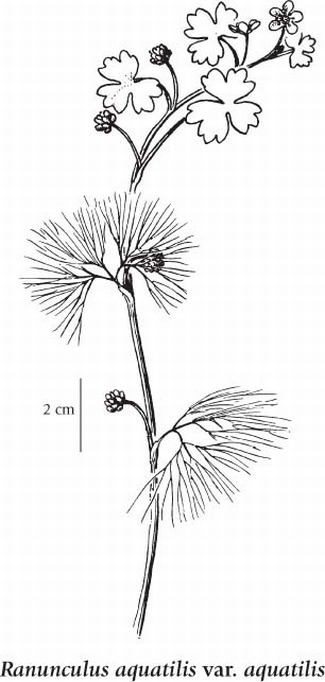Click on the image below to view an
expanded illustration for this species.

|
General:
Aquatic, perennial herb, rooting from nodes of lower stems; stems weak, few-branched, creeping or floating, 20-80 cm long, often mat-forming, smooth.
Leaves:
All alternate stem leaves, of two possible types, the floating leaves usually kidney-shaped, 3-parted, 5-8 mm long, 9-15 mm wide, the leaflets elliptic or egg-shaped, margins often notched, unstalked or the stalks 15-40 mm long, the submerged leaves 3 to 5 times 3-dissected, the segments thread-like, the stalks 1-12 mm long; leaves, stalks and stipule-sheaths usually fine-hairy.
Fruits:
Achenes, 10 to 20 in an egg- to globe-shaped head 2-4 mm long, 2-5 mm wide, the achenes egg-shaped, flattened, 1-2 mm long, 0.8-1.4 mm wide, smooth or stiff-hairy; beaks persistent, thread-like, 0.1-1.2 mm long.
Notes:
The taxonomy of the R. aquatilis complex, at least in North America, remains unclear. The treatment by Whittemore (1997), which we have followed, has included some of our W North American plants with the Eurasian var. aquatilis. The recognition of only two varieties in BC, at least until taxonomic problems are resolved, appears to be the only realistic treatment.
1. Floating leaves simple and dissimilar to the submerged, filiform leaves................. var. aquatilis
1. Floating leaves, if any, similar to the submerged, filiform leaves.................. var. diffusus With.
Source: The Illustrated Flora of British Columbia
|
